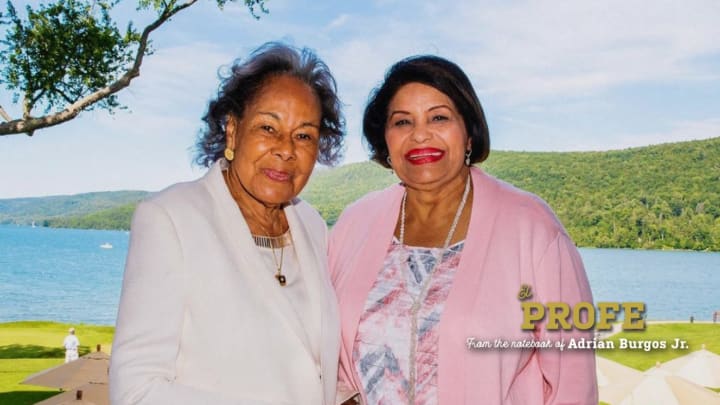El Profe: 21 Forever
By Adrian Burgos

21.
The Great One.
Roberto Clemente Walker.
We know him by his number, nickname and his birth name.
He stands alone among the baseball immortals for the combination of how he played the game, the way he lived his life and how it came to an end.
It seems a higher power preordained that Clemente would forever stand at the gate of baseball immortality: exactly 3,000 career hits. Not one more, not one less.
Family Time
Last summer I shared the stage at the All-Star Game Fan Fest with the Clemente family. For fellow Puerto Ricans and perhaps most other Latinos, the Clementes remain baseball royalty. They are the family of the Great One. They are the ones who provided him a purpose beyond the playing field. They surrounded him with love, laughter and the quiet moments of time with family. They are the ones who shared their husband and papi with the rest of us.
It was special hearing Doña Vera, his widow, speak in her soft voice, whether in English or Spanish. It was also special to hear Luis Clemente share memories of their years in Pittsburgh and of the bond they shared with those like Manny Sanguillen, José Págan and the other Pirates teammates.
Born in 1969, I was not able to see Roberto Clemente perform live. Like others of my generation, I witnessed the greatness of Clemente through videotapes. Now in the YouTube era anyone can watch his amazing 1971 World Series performance, post-game speech, or just about any other grand moment with a simple web search.
Although that provides us a connection to the filmed Clemente, it does not fully show the person he was nor does it truly give us a sense of the powerful hold he had – and still has – on those who knew him.
Like many other baseball fans, the Clemente family is my one degree of separation from the ballplayer Roberto Clemente and the direct connection to the family man that he was.
Unforgettable Visit
Getting to know more about Clemente the person meant a visit to Ciudad Deportiva, which is Clemente’s Sports City, in his hometown of Carolina, Puerto Rico. I made my first trip there while I was doing research for my doctoral dissertation in 1996.
Until that point, I had spent hours going through reels of microfilmed newspaper articles, getting to know Clemente and the generation of pioneering black Latinos in the major leagues.
Microfilm, however, flattens out the three-dimensional Clemente. When we read those old newspaper articles, we get a sense of Clemente through the writers’ and editors’ selection of words describing his performance, role on the team or attitude. It’s their Clemente, the one they wanted to convey to their audience then. That is why we often read of a “moody” superstar, one described as a hypochondriac, one who challenged their sensibilities and racial attitudes.
To get more of the three-dimensional person that Clemente was meant talking with Doña Vera.
Arriving at Sport City in Carolina early, I took a walk around the complex. The 1996 visit was my first visit to the place that Clemente had dreamed of, where he could provide opportunities for Puerto Rican youths to pursue athletic endeavors and offer them another route toward self-improvement.
Back then, there were several baseball diamonds spread around the complex along with outdoor volleyball and basketball courts. In front of the museum where I was scheduled to interview Doña Vera, there was also the beautiful statue of Clemente that greets visitors.
I was led to Doña Vera’s office in the museum and she greeted me warmly. We exchanged pleasantries and she asked where my family was from. “Mami es de Caguas and papi es de Manati.” But I mentioned I had cousins from nearby Barrio Barrazas. I can still recall her smile when I mentioned Barrazas, and her mentioning the many good, hard-working campesinos up there, not too far from where Roberto grew up.
We talked more about family than the time he spent playing in Pittsburgh. The memories she shared transported us back to her days working as a bank teller in the downtown section of Carolina and of her courtship with Roberto. Those were different times, but he was a very traditional man, asking her father’s permission to court his daughter and chaperoned on their outings.
The love of being a family man came across through the stories she shared. She mentioned Roberto’s desire of wanting to be present for his kids and his always longing to return to Puerto Rico.
It was palpable, hearing the loving way she spoke about him there in the office in the museum. One could feel that it was still there, the connection to the man she loved dearly, to the legacy she has sought to maintain, of encouraging others to live up to the words Roberto left us with.
“Any time you have an opportunity to make a difference in this world and you don’t, then you are wasting your time on Earth,” he famously said.
Interviewing the Clemente family at FanFest and sharing the stage with them as Doña Vera inducted fellow Puerto Rican Bernie Williams into the Hispanic Heritage Baseball Museum Hall of Fame, I witnessed once more the power of 21 and the Clemente family. It was in the reverence with which Bernie spoke in thanking Vera Clemente, how the Clementes had given us something so valuable in sharing themselves and their memories of the Great One with us, always reminding us of the person in three-dimensions that was Roberto Clemente, and not just the one captured on tape.
Featured Image: Jean Fruth / La Vida Baseball